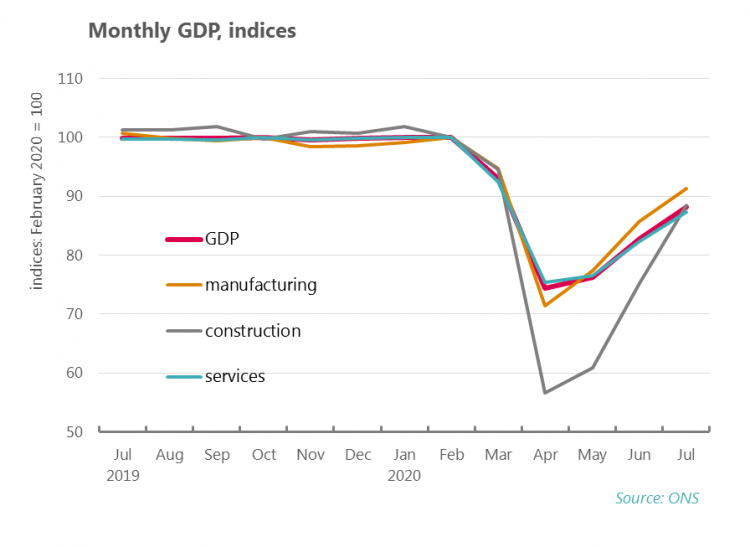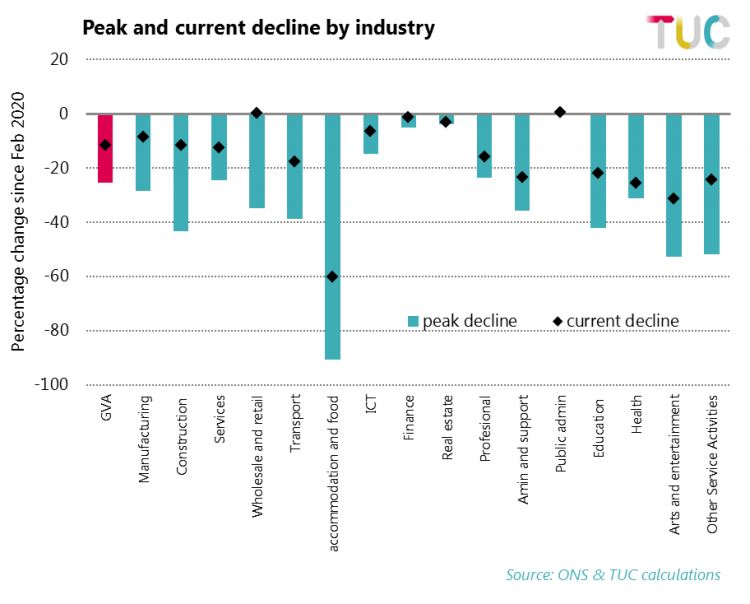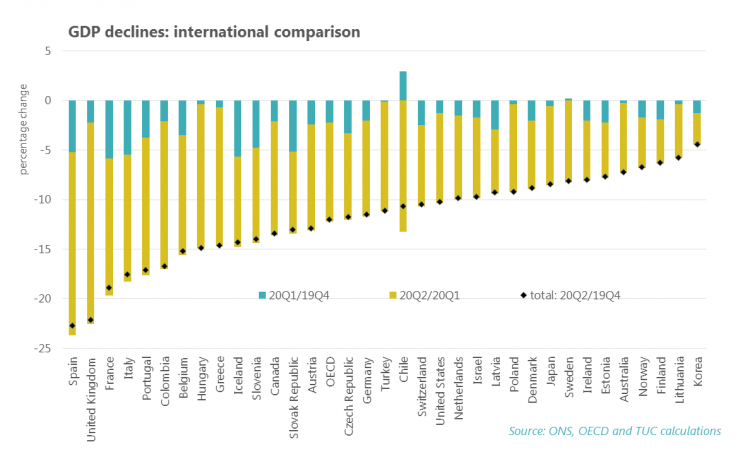GDP rebound continues but very mixed story by industry
GDP shows the economy continuing to come back as the lockdown was eased, but many industries still with massive ground to make up, and danger ahead as the furlough scheme ends. We are urging the Chancellor quickly to get in place a successor job protection and upskilling programme.
Monthly revival continues
GDP grew by 6.6% into July as the lockdown continued to ease. GDP is now 18.6% higher than its April 2020 low. However, it remains 11.7% below the levels seen in February 2020, before the full impact of the coronavirus pandemic (red line on the chart below). As ONS director of economic statistics Darren Morgan put it
While it has continued steadily on the path towards recovery, the UK economy still has to make up nearly half of the GDP lost since the start of the pandemic.
Some service industries left behind
As the previous chart illustrates, construction fell further and recovered more, so that three quarters of ground lost is made up but activity in July is still down 11% on February. Manufacturing has gained a little more, making up 2/3 of lost ground and down 8.7% on February. Though there is a mixed performance between different manufacturing industries. At one extreme is pharmaceuticals, up 10% on February; at the other extreme are the heavier industry categories, most strikingly transport equipment which has recovered just over half the ground lost and still stands 27% down on February (see chart 4 in the ONS commentary).
Because of its size, the service sector as a whole matches the GDP performance (the blue and red lines are on top of each other). The chart below, however, captures better the varied performance within the service sector.
The columns indicate the peak decline, and the diamonds the current position.
On the upside retail is the most striking, having recovered all the ground lost – though as we already know from the separate release this has involved some heavy restructuring towards on-line. Other sectors with minimal declines are finance, real estate and public administration.
However, for six industries, output in July is still more than 20% below the February position. Most obviously accommodation and food is still 60% down – it will be interesting to see how ‘eat out to help out’ supports activity next month. The other hefty declines are in private sector administrative and support activities, education, health, arts and entertainment, and the miscellaneous ‘other activities’ category.
Professional services are a huge category (lawyers, architects etc) and in proportional terms have made up the least ground of all service activities (only one third). This is striking given a good deal of homeworking is likely here, and suggestive of a wider slump in activity – and there is no eat out to help out for this sector.
Quarterly decline the worst of all advanced economies
These monthly figures provide a more timely sense of what is going on than the usual quarterly figures, and peek beyond the second quarter. But we should not forget the severity of the UK decline. Figures are now in for all OECD countries apart from Luxembourg and New Zealand. In quarter two the UK decline of 20.4% was steepest of all countries and double the OECD average of 9.9%. Over the first half of the year the UK was second worst (to Spain) of all OECD countries.
TUC warns against recovery losing momentum with abrupt end to JRS
Looking beyond the headline figures shows a highly uneven performance across different parts of the economy, with some activities operating at greatly reduced levels. Moreover, government support has been critical, and, as Frances O Grady puts it:
The big danger now is that the recovery loses momentum because of a surge in unemployment when the job retention scheme ends. The government must not throw away the good work of the scheme by ending it too abruptly. We need a successor scheme for businesses with a viable future that need support for longer.
The TUC proposals for a Job Protection and upskilling scheme are set out here.
Stay Updated
Want to hear about our latest news and blogs?
Sign up now to get it straight to your inbox



